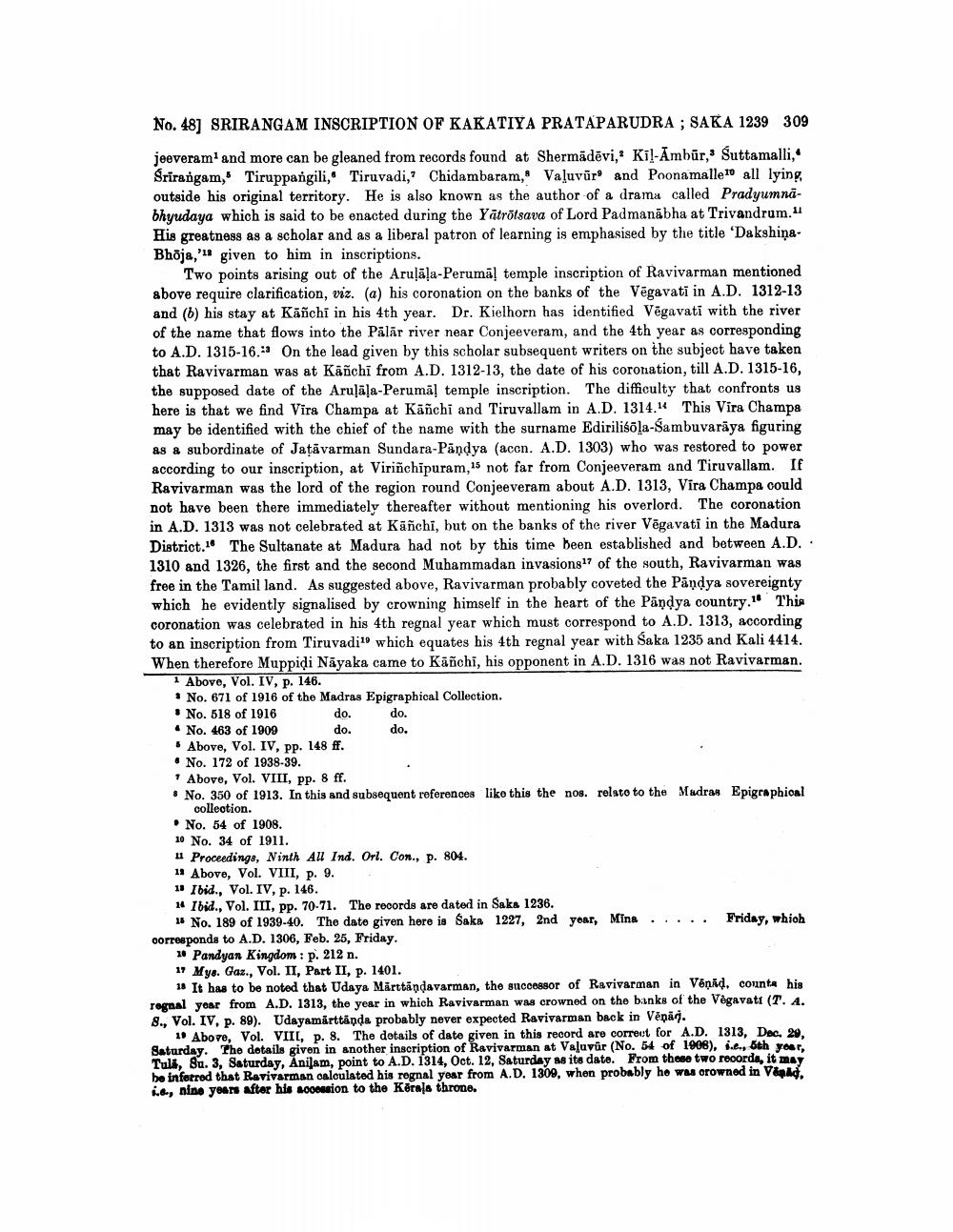________________
No. 48] SRIRANGAM INSCRIPTION OF KAKATIYA PRATAPARUDRA; SAKA 1239 309
jeeveram1 and more can be gleaned from records found at Shermadevi, Kil-Ambur, Suttamalli, Srirangam, Tiruppangili, Tiruvadi, Chidambaram, Valuvur and Poonamalle all lying outside his original territory. He is also known as the author of a drama called Pradyumnabhyudaya which is said to be enacted during the Yatrotsava of Lord Padmanabha at Trivandrum." His greatness as a scholar and as a liberal patron of learning is emphasised by the title 'DakshinaBhoja,' given to him in inscriptions.
Two points arising out of the Arulala-Perumal temple inscription of Ravivarman mentioned above require clarification, viz. (a) his coronation on the banks of the Vegavati in A.D. 1312-13 and (b) his stay at Kañchi in his 4th year. Dr. Kielhorn has identified Vegavati with the river of the name that flows into the Palar river near Conjeeveram, and the 4th year as corresponding to A.D. 1315-16. On the lead given by this scholar subsequent writers on the subject have taken that Ravivarman was at Kañchi from A.D. 1312-13, the date of his coronation, till A.D. 1315-16, the supposed date of the Arulala-Perumal temple inscription. The difficulty that confronts us here is that we find Vira Champa at Käñchi and Tiruvallam in A.D. 1314.14 This Vira Champa may be identified with the chief of the name with the surname Ediriliśōla-Sambuvaraya figuring as a subordinate of Jatavarman Sundara-Pandya (accn. A.D. 1303) who was restored to power according to our inscription, at Virinchipuram, 15 not far from Conjeeveram and Tiruvallam. If Ravivarman was the lord of the region round Conjeeveram about A.D. 1313, Vira Champa could not have been there immediately thereafter without mentioning his overlord. The coronation in A.D. 1313 was not celebrated at Kañchi, but on the banks of the river Vegavati in the Madura District. The Sultanate at Madura had not by this time been established and between A.D.. 1310 and 1326, the first and the second Muhammadan invasions of the south, Ravivarman was free in the Tamil land. As suggested above, Ravivarman probably coveted the Pandya sovereignty which he evidently signalised by crowning himself in the heart of the Pandya country. This coronation was celebrated in his 4th regnal year which must correspond to A.D. 1313, according to an inscription from Tiruvadi1 which equates his 4th regnal year with Saka 1235 and Kali 4414. When therefore Muppidi Nayaka came to Käñchi, his opponent in A.D. 1316 was not Ravivarman. 1 Above, Vol. IV, p. 146.
18
No. 671 of 1916 of the Madras Epigraphical Collection.
No. 518 of 1916
do.
do.
No. 463 of 1909
do.
do.
Above, Vol. IV, pp. 148 ff.
No. 172 of 1938-39.
Above, Vol. VIII, pp. 8 ff.
No. 350 of 1913. In this and subsequent references like this the nos. relate to the Madras Epigraphical
collection.
No. 54 of 1908.
10 No. 34 of 1911.
Proceedings, Ninth All Ind. Orl. Con., p. 804.
18 Above, Vol. VIII, p. 9.
1 Ibid., Vol. IV, p. 146.
14 Ibid., Vol. III, pp. 70-71. The records are dated in Saka 1236.
15 No. 189 of 1939-40. The date given here is Saka 1227, 2nd year, Mina
Friday, which
corresponds to A.D. 1306, Feb. 25, Friday.
1 Pandyan Kingdom: p. 212 n.
17 Mys. Gaz., Vol. II, Part II, p. 1401.
18 It has to be noted that Udaya Märttändavarman, the successor of Ravivarman in Venäḍ, counts his regnal year from A.D. 1313, the year in which Ravivarman was crowned on the banks of the Vegavati (T. A. 8., Vol. IV, p. 89). Udayamärttända probably never expected Ravivarman back in Vēņāj.
1 Above, Vol. VIII, p. 8. The details of date given in this record are correct for A.D. 1313, Dec. 29, Saturday. The details given in another inscription of Ravivarman at Valuvür (No. 54 of 1908), i.e., 5th year, Tula, Su. 3, Saturday, Anilam, point to A.D. 1314, Oct. 12, Saturday as its date. From these two records, it may be inferred that Ravivarman calculated his regnal year from A.D. 1309, when probably he was crowned in Vanad, i.e, nine years after his accession to the Kerala throne.




